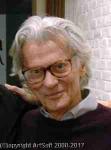Richard Avedon
Richard Avedon
Place: New York City
Born: 1923
Death: 2004
Biography:
Richard Avedon was an American fashion and portrait photographer. An obituary published in The New York Times said that "his fashion and portrait photographs helped define America's image of style, beauty and culture for the last half-century".
Avedon was born in New York City, to a Jewish family. His father, Jacob Israel Avedon, was a Russian-born immigrant who advanced from menial work to starting his own successful retail dress business on Fifth Avenue, called Avedon’s Fifth Avenue. His mother, Anna, from a family that owned a dress-manufacturing business, encouraged Richard's love of fashion and art. Avedon’s interest in photography emerged when, at age 12, he joined a Young Men’s Hebrew Association (YMHA) Camera Club. He would use his family’s Kodak Box Brownie not only to feed his curiosity about the world, but also to retreat from his personal life. His father was a critical and remote disciplinarian who insisted that physical strength, education and money prepared one for life. The photographer's first muse was his younger sister, Louise. During her teen years she struggled through psychiatric treatment, eventually becoming increasingly withdrawn from reality and diagnosed with schizophrenia. These early influences of fashion and family would shape Avedon's life and career, often expressed in his desire to capture tragic beauty in photos.
Avedon attended DeWitt Clinton High School in Bedford Park, Bronx, where from 1937 until 1940 he worked on the school paper, The Magpie, with James Baldwin. As a teen he also won a Scholastic Art and Writing Award. After graduating from DeWitt Clinton that year he enrolled at Columbia University to study philosophy and poetry but dropped out after one year. He then started as a photographer for the Merchant Marines, taking ID shots of the crewmen with the Rolleiflex camera his father had given him. From 1944 to 1950 Avedon studied photography with Alexey Brodovitch at his Design Laboratory at The New School for Social Research.
In 1944, Avedon began working as an advertising photographer for a department store, but was quickly endorsed by Alexey Brodovitch, who was art director for the fashion magazine Harper's Bazaar. Lillian Bassman also promoted Avedon's career at Harper's. In 1945 his photographs began appearing in Junior Bazaar and, a year later, in Harper's Bazaar.
In 1946, Avedon had set up his own studio and began providing images for magazines including Vogue and Life[vague]. He soon became the chief photographer for Harper's Bazaar.[citation needed] From 1950 he also contributed photographs to Life,[vague] Look and Graphis and in 1952 became Staff Editor and photographer for Theatre Arts Magazine.[citation needed] Avedon did not conform to the standard technique of taking studio fashion photographs, where models stood emotionless and seemingly indifferent to the camera. Instead, Avedon showed models full of emotion, smiling, laughing, and, many times, in action in outdoor settings which was revolutionary at the time.[citation needed] However, towards the end of the 1950s he became dissatisfied with daylight photography and open air locations and so turned to studio photography, using strobe lighting.
When Diana Vreeland left Harper's Bazaar for Vogue in 1962, Avedon joined her as a staff photographer. He proceeded to become the lead photographer at Vogue and photographed most of the covers from 1973 until Anna Wintour became editor in chief in late 1988. Notable among his fashion advertisement series are the recurring assignments for Gianni Versace, beginning with the spring/summer campaign 1980. He also photographed the Calvin Klein Jeans campaign featuring a fifteen-year-old Brooke Shields, as well as directing her in the accompanying television commercials. Avedon first worked with Shields in 1974 for a Colgate toothpaste ad. He shot her for Versace, 12 American Vogue covers and Revlon's Most Unforgettable Women campaign.[citation needed] In the February 9, 1981, issue of Newsweek, Avedon said that "Brooke is a lightning rod. She focuses the inarticulate rage people feel about the decline in contemporary morality and destruction of innocence in the world." On working with Avedon, Shields told Interview magazine in May 1992 "When Dick walks into the room, a lot of people are intimidated. But when he works, he's so acutely creative, so sensitive. And he doesn't like it if anyone else is around or speaking. There is a mutual vulnerability, and a moment of fusion when he clicks the shutter. You either get it or you don't".
In addition to his continuing fashion work, by the 1960s Avedon was making studio portraits of civil rights workers, politicians and cultural dissidents of various stripes in an America fissured by discord and violence. He branched out into photographing patients of mental hospitals, the Civil Rights Movement in 1963, protesters of the Vietnam War, and later the fall of the Berlin Wall.
More...
Wikipedia link: Click Here












